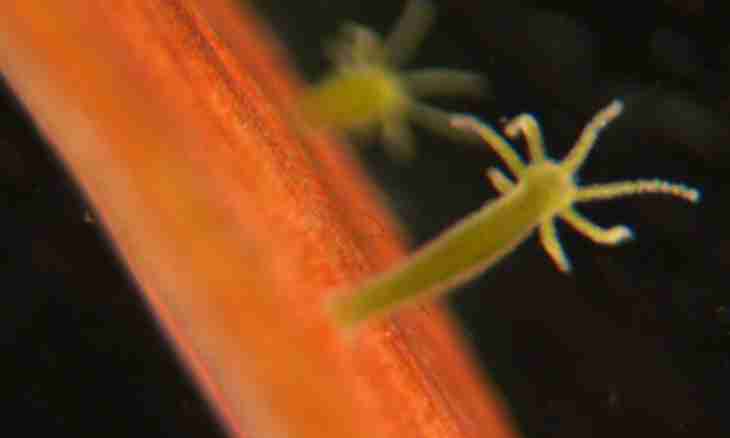The freshwater hydra is the typical representative of coelenterates of animals living in lakes, ponds and creeks of the rivers. The first A. Levenguk, the inventor of a microscope and the famous naturalist saw and described a hydra.
Structure of a freshwater hydra
This freshwater polyp looks as the short, jellylike and translucent tube of the size of grain surrounded with a nimbus from 6-12 tentacles. On the front end of a body there is an oral opening, the back end of a hydra is narrowed in a long leg with a sole on the end. The full hydra has length about 5 mm, hungry is much longer.
Food and way of life
The freshwater hydra eats a Cyclops, water fleas, larvae of mosquitoes and whitebaits of fishes. She is attached to plants by a sole and slowly shaken, moving long tentacles extensively, finding production. Tentacles are covered with sensitive eyelashes to which at touch the strekatelny thread paralyzing the victim is thrown out.
Production is tightened by a tentacle to an oral opening and absorbed. Having digested swallowed, the hydra throws out the digestion remains through the same opening. At successful hunting this small predator can absorb enormous amount of food, several times there is more volume. Having a translucent body, the hydra accepts color of the eaten food and is red, green or black.
Reproduction of a hydra freshwater
At good food the freshwater hydra quickly begins to bud (asexual reproduction). Kidneys grow from a small hillock to completely created individual for several days. In the beginning young hydras are connected to a maternal body, but after formation of a sole they separate and begin independent life. The hydra usually buds in the summer. At a cold snap or in adverse conditions (hunger) of a hydra breed the eggs which are formed in an outer layer of a body. The ripened egg becomes covered by a strong cover and gets on a reservoir bottom. After formation of eggs the old individual usually perishes. Reproduction by means of eggs is called sexual reproduction. That is, in life of a freshwater hydra both ways of reproduction are replaced.
Regeneration at a freshwater hydra
Hydras have surprising ability to regeneration. If to cut an individual on two parts, then at everyone tentacles and a sole will very quickly grow. The experiments made by the Dutch zoologist Tramble at which he managed to receive new hydras from the smallest pieces are known and even to splice among themselves halves of different hydras. As showed modern researches, such restoration of fabrics and bodies is provided by stem cells of an animal.

